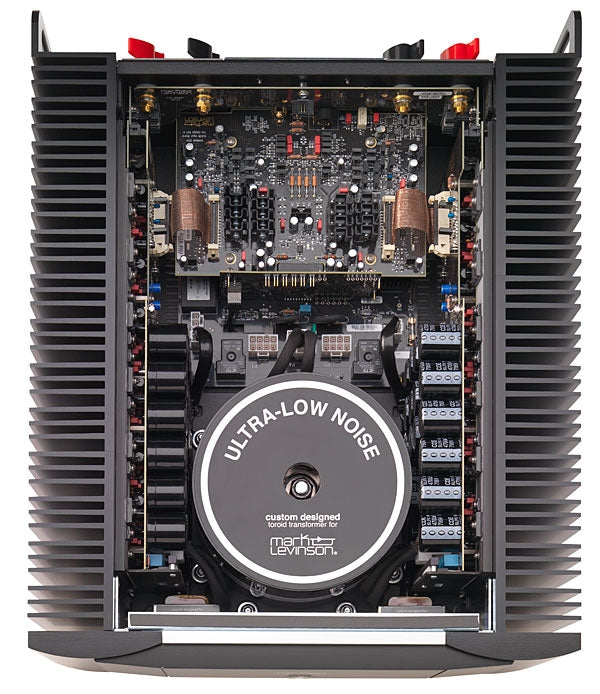This fully differential, fully discrete, monaural Pure Path amplifier drives virtually any loudspeaker effortlessly for impeccable imaging, musicality, and openness. A direct-coupled signal path; a highly linear, low-feedback design; and voltage gain and drive stages operating in class A, are joined by the modern system integration capabilities provided by Ethernet, RS-232, and USB for monitoring and network control.
Pure Path Circuit Design
Since 1972, Mark Levinson has been dedicated to the uncompromising art of sound, with the guiding principle of musical purity above all else. To achieve that goal like never before, Mark Levinson engineers scoured company archives, ultimately developing a circuit-design philosophy called Pure Path. On a conceptual level, its hallmark principles include a discrete, direct-coupled, fully balanced, dual-monaural signal path that delivers unrestricted, uncompromised sonic purity. Far from merely arranging components in an intelligent manner, Pure Path is the meeting of science and art: Mark Levinson engineers are tasked to create the best possible measured AND subjective performance. To quote Albert Einstein: “Everything should be made as simple as possible, but not simpler." Pure Path highlights in the No. 523 include Folded , an R-2R Ladder volume control, the class-A Pure Phono stage, and class-A Main Drive Headphone amplifier output.
The Folded Cascode
Mark Levinson components are designed around a Pure Path amplifier circuit concept that makes heavy use of a circuit design element called a . Originally created for improving the bandwidth of vacuum tube circuits in radios, Mark Levinson engineers deploy in Pure Path circuit designs to both improve bandwidth and enhance linearity. A combines two transistors so that they operate as a single composite device that functions a single transistor, using the wanted characteristics of each component transistor, and rejecting the unwanted characteristics.
Mark Levinson engineers began their design of the gain stage with pairs of JFETs (junction field-effect transistors), chosen for their low noise and high gain. JFETs achieve these characteristics in part by being large, and with their large size comes nonlinear gain – or distortion. To mitigate this, BJTs (bipolar junction transistors) were added to the circuit. The BJTs exhibit very low input impedance and very high output impedance, which translates to excellent bandwidth and linearity. By creating a of the JFETs and BJTs, they created a design with the best characteristics of both sets of devices.
Engineers than connected the output of the to another transistor of the opposite “gender." Current flows through it in the opposite direction to “turn around" the direction of the signal current. This special connection is called a Folded Cascode and it is a hallmark of the Pure Path circuit: high gain with low noise, wide bandwidth, and excellent linearity.
Gain Structure
The audio circuitry in the No. 536 has been optimized for the best possible open-loop performance. As a result, very little negative feedback is necessary, and the amount employed could be adjusted to achieve certain subjective or objective results. The open-loop gain and bandwidth of the circuit were painstakingly set using precision resistors and compensation capacitors, and additional precision resistors were employed to compose the feedback network.
Military Grade Components
All Mark Levinson equipment employs electronic components carefully chosen for their specific task. Gain-stage JFET pairs have high gain, low noise, low distortion, and because they are encapsulated in the same package, the two devices operate under nearly identical conditions. Capacitors used in critical filtering locations are film types, noted for their consistent performance regardless of temperature and frequency. Finally, resistors in critical gain-setting and feedback locations use tantalum nitride thin-film elements. An extremely costly material, tantalum nitride typically finds use in sensitive military equipment because it is unusually stable with respect to temperature, exhibits very low noise, and is unaffected by magnetic fields. In fine audio equipment, those characteristics make the sound even more revealing and effortless, free of the low-level nonlinearities caused by lesser resistive materials as they heat and cool under dynamic conditions. Housed in an aircraft-grade 6063-T5 extruded aluminum chassis, the No. 523 features extremely high build precision, to exceedingly low tolerances.
Completing the Signal Path
The No. 536 offers balanced and single-ended inputs for use with virtually any preamplifier or source player with variable output. For connection to loudspeakers without needing tools for a secure link, the No. 536 features two pairs of gold-plated binding posts with Mark Levinson Hurricane terminal knobs to support either standard or bi-wired loudspeaker connections. Speaker cables terminating in banana plugs can be used in the USA and other non-European countries.
System-integration connectivity includes Ethernet/IP control, RS-232, USB for monitoring and configuration via page, plus 12V triggers.
Specifications
Input connectors: one Balanced, one single-ended
Speaker Connectors: two pairs of Hurricane loudspeaker outputs banana-plug sockets per channel
Control I/O: Ethernet, RS-232, Trigger In and Out, USB-A, Mini USB
Rated Output Power:
400 wpc RMS @ 8Ω
20Hz to 20kHz @ <0.3% THD, full output from 2.83VRMS
Frequency Response: 10Hz to 20kHz ±0.2dB
Signal-to-Noise Ratio: >85dB, reference level: 2.83 VRMS
Input Impedance: 60 kΩ balanced; 30 kΩ unbalanced
Voltage Gain: 26dB
Input Sensitivity: 2.83VRMS output at 142mVRMS input
Power Requirements: 100V~, 120V~, 230V~, factory set for destination country, 1500W
Dimensions (HWD): 7.75" x 17.75" x 20"
Weight: 114 lbs.


